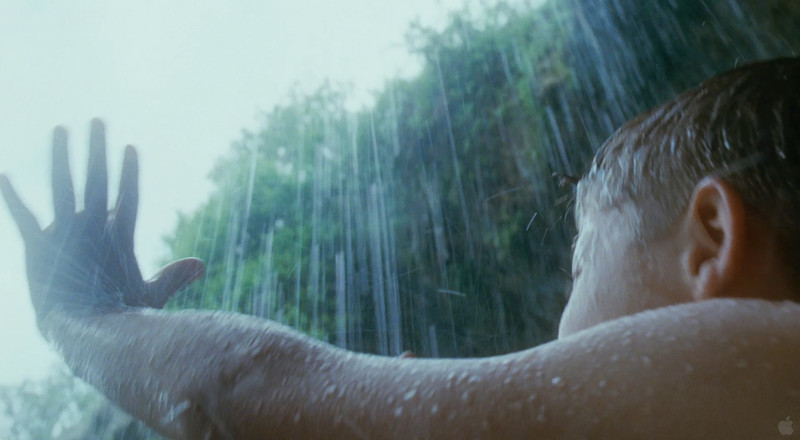Wherever one
lands on the polarizing style of Terrence Malick, no one would deny the
spiritual gravitas of his work—cinema obsessed with and overwhelmed by the
mystical and the metaphysical. As much as has been said and written about
Malick, there still remains debate and confusion around the spirituality of his
films. In attempting to mine meaning from his work, folks continue to land all
over the map, seeing him as everything from a pantheist to an agnostic. The sense of mystery is compounded because Malick is an artist before
he is a theologian or philosopher, and because he hasn’t given an
interview about his own films since 1979.
All that said, I believe Malick’s
cinema is not vaguely or ambivalently religious or spiritual but is, in fact, distinctly and explicitly Christian.
More specifically, I
believe Malick’s films are evangelical; they function as cinematic “liturgies”
that seek to orient the hearts and minds of viewers toward the Christian
story—a way of seeing and interacting with God and the world—helping us, as
Private Witt says in “The Thin Red Line,” recover the good within us and reach
out to touch the glory.
Christian
philosopher James K. A. Smith, in his book Desiring
the Kingdom, says that liturgies “shape and constitute our identities by
forming our fundamental desires and our most basic attunement to the world. In
short, liturgies make us certain kinds of people, and what defines us is what
we love. They do this because we are the sorts of animals whose orientation to
the world is shaped from the body up more than the head down. Liturgies aim our
love to different ends precisely by training our hearts through our bodies.
They prime us to approach the world in a certain way, to value certain things,
to aim for certain goals, to pursue certain dreams, to work together on certain
projects.”
Smith’s belief
that human beings are primarily lovers rather than thinkers is, of course,
nothing new; it is an understanding founded in Scripture, as well as the
thought of early Christian theologian and philosopher St. Augustine of Hippo.
Augustine, in perhaps his most famous work, City
of God, argues that humans are innately lovers or worshippers, which means
that it is not whether people worship; it is what people worship. As a direct
consequence, there are liturgies—most affectively stories—all around us that
prime the pump of the heart, shaping its affections and desires toward a vision
of the good life.
Appealing to
our emotions and imaginations, liturgies use kinesthetics and aesthetics to
teach and change the human condition around a particular story or vision. Out
of this understanding, Smith ultimately calls for a response. He challenges
Christians to reconsider anew the liturgy of the Church, taking back 2,000 years of tradition; moreover, he challenges Christians to create alternative,
sacred liturgies in light of the numerous bad liturgies within popular culture.
In one sense, Smith’s is a call to the arts—or, in Malick’s case, cinema.

Malick’s films function as cinematic liturgies that paint a distinctly Christian picture
of the good life—the kingdom of God—reflecting the gospel story of creation,
fall, redemption and restoration. More so, Malick’s works embody a unique
lyrical, poetical form that, like music, does not only create emotion in
viewers but also shapes viewers.
In an essay
on “To the Wonder,” film critic Nick Olson underscores the formative nature of
Malick’s lyrical style: “[Malick] seems to me to be pressing for us to awaken
our own inner depths of subjectivity and inhabit the outlines he’s setting
forth. He wants these grace notes to profoundly shape us—to impress upon us in
the most personal way.”
On the one
hand, there are a number of Christian ideas on the surface of Malick’s work,
whether it be the locusts in “Days of Heaven” that parallel the plagues of
Egypt from the book of Exodus or the theological debate between Witt and Welsh
in “The Thin Red Line.” But the presence of such symbols and themes isn’t
necessarily the thing that distinguishes Malick’s work. After all, there are a
number of movies, books and stories that allude to the Bible—it’s one of the
most significant pieces of literature in history.
On the other hand, when digging deeper beyond the surface, there lies a
particular spirituality—a distinctly Christian spirituality—that supersedes
these many elements. At the bottom of Malick’s work, there is a prominent,
consistent narrative and vision that drives it forward—that of the Christian
story. This story is, first and foremost, what makes Malick’s films liturgical
in a Christian sense.
While all of
his films fall in line with the Christian meta-narrative to some degree while
boasting a yearning for Eden, Malick realizes this story mainly through
the concept of nature and grace.
“The Tree of
Life,” a film which not only epitomizes the ethos of Malick but also provides a
microscope by which to see all his films, deals with this concept the most
explicitly. In a voice-over at the beginning of the film, we hear Mrs. O’Brien
(Jessica Chastain) explain two ways through life: “the way of grace” and “the
way of nature.” She states, “Grace
doesn’t try to please itself. Accepts being slighted, forgotten, disliked.
Accepts insults and injuries … Nature only wants to please itself. Get others to
please it over them. To have its own way.”
Influenced by
Christians thinkers like Augustine and Thomas Aquinas and actually lifted
directly from Thomas à
Kempis’ The Imitation of Christ,
these words don’t merely express a generic, universal morality about being good
or being bad; they make up a distinct Christian doctrine about the nature of
humankind and the grace of God through Jesus Christ.
Malick affirms the Christian distinctiveness of the
concept in a church scene: “Is there nothing which is deathless, nothing which does not pass away?,”
the preacher asks the congregation, and the camera pans on a stained glass
portrait of Jesus Christ. The preacher goes on, “We cannot stay where we are.
We must journey forward. We must find that which is greater than fortune or
fate. Nothing can bring us peace but that.”

While more
obvious than subversive in “The Tree of Life,” this theme of nature and grace
appears all throughout Malick’s body of work. Though probably an
oversimplification, Malick’s first two feature films, “Badlands” and “Days of
Heaven,” function as moral parables, showing the consequences of a life lived
by the way of nature via Kip and Bill. In “The Thin Red Line,” the narrator
poses two different ways of seeing the world—one that leads to war and
destruction and another that, motivated by a future hope, seeks sacrifice and
reconciliation, which is reflected in the film’s final words: “Oh, my soul. Let me be in you
now. Look out through my eyes. Look out at the things you made. All things
shining.”
The dualism of nature and grace emerges, as well, in
“The New World” and “To the Wonder.” In the latter, Father Quintana wrestles
with his faith yet he eventually finds renewal through good works, for caring
for the poor and visiting the sick, for showing love to the “least of these.”
In a powerful montage where this transfiguration plays out, Malick highlights
the way of grace, and citing the words of St. Patrick, he clearly points to
Christ as the center of this grace. The scene ends with a prayer from Cardinal
Newman: “Flood our souls with your spirit and life so completely that our lives
may only be a reflection of yours. Shine through us. Show us how to seek you.
We were made to see you.”
Malick’s latest, “Knight of Cups,” might actually be
the clearest expression of the nature and grace concept. As many have already
noted, the film functions as a modern adaptation of The Pilgrim’s Progress, with multiple references to the Christian
allegory. Through the spiritual journey of a Hollywood screenwriter from
hedonism to redemption, Malick appeals to the way of grace. In an article
for MUBI, Josh Cabrita fleshes out this concept: “The realization that comes through
all of the director’s films, and especially in ‘Knight of Cups,’ is the same
discovery that Christian makes in The
Pilgrim’s Progress: ‘Then I perceive it is not best to covet things that are
now, but to wait for things to come.’ This line of thought is very platonic:
that the things of this world are just cheaper copies of greater ideals, merely
shadows projected on the wall of a cave. It’s also a distinctly Christian
worldview.”
Through the
concept of nature and grace, particularly the way of grace, Malick’s films
offer a vision of human flourishing and the good life that falls directly into
the Christian story. As Peter M. Candler notes in an essay on
Malick called “The Glory of Love’s New World,” “The difference between the way
of nature and the way of grace could be summed up very simply: it’s the
difference between prodigality and self-dispossession, between throwing it all
away and giving it all away.”
That said,
when looking at the whole of Church history, the Christian liturgy is not only
distinguished by its story but also its form, which matches its unique content.
The goal is to tell a story but in a way that sinks deep into our bones
because, as Smith puts it, “adequate liturgics must assume a kinesthetics and a
poetics, precisely because liturgies are compressed, performed narratives that
recruit the imagination through the body.”

In her book Liturgical Art for a Media Culture,
Eileen D. Crowley argues that aesthetics are essential to liturgies, and aesthetics
require a “sense of time, timing, rhythm, pacing, and tempo”; she goes on to
say that video aesthetics necessitate “consideration of motion, rhythm, tempo,
timing, repetition, flow, and careful use of sound and silence.” Though all movies technically function as
“liturgies,” given their formative power, there are particular movies that work
better than others—movies with this “sense of aesthetics,” particularly a
poetic aesthetic that marries the message and vehicle.
The films of
Terrence Malick epitomize this sort of film; they embody a style that, similar
to music, catches us—not only stirring our thoughts and emotions but, in turn,
shifting and shaping them. Malick does this by capturing the theological and
philosophical content of his films—what is at its core, the Christian
story—visually and auditorily. In creating the ideal vehicle for his message,
Malick invents a singular, lyrical style; it is a style that works less like
entertainment and more like a sacrament.
Essentially,
Malick’s is a cinema intentionally liturgical—put together in a way that will get into the gut of its viewer—in a way that will somehow change that
individual, if even for a moment.
Comparing “The
Tree of Life” to the book of Job, which it cites on more than one occasion,
author Peter J. Leithart notes that the point of Job isn’t to answer the
problem of evil but to teach us how to respond to evil; it is to show that the
good and right response is worship. We see this play out in the characters of
the film, as they experience pain and suffering, but Malick doesn’t just let us
see these characters respond with worship; he invites us to worship. In the
first half of “The Tree of Life,” following the news of the death, Mrs. O’Brien
asks the question, “Where were you?” and the film cuts to the twenty-minute
creation sequence in which we literally see the Creator lay the foundations of
the world. In this structure, Malick answers his character’s question with a
reference to the film’s opening quote from Job: “Where were you when I laid the
foundations of the earth, and the morning stars sang together?” Placing Mrs.
O’Brien in perspective to the God of the universe, it is though Malick states
Leithart’s words: “A God who made such a world, a world designed for man, a
world through which glory shines, should be loved and trusted.” Malick does not
only tell us this truth in the plot, but he makes us feel it in the sound and
images of the creation sequence. Whether it’s the visual scope and scale or the operatic
“Lacrimosa” from Zbigniew Preisner’s “Requiem
for my Friend,” this sequence demands that we stand in awe of and worship.

Given its profundity, as displayed in “The Tree of Life,” much has been written of
Malick’s use of music. In The
Cinema of Terrence Malick, James Wierzbicki devotes a chapter to
the subject, inadvertently underscoring the liturgical nature of Malick’s
films. Wierzbicki writes of his second experience watching “Days of Heaven“ that he “…realized
that [he] had been caught up by sonic stimuli whose pattern of stasis, tension and
eventual relaxation—whose dynamic juxtaposition of consonance and dissonance—not
only bore an oblique relationship to the emotional content of the film’s
narrative but beautifully fit the phenomenological model for musical
expressivity.”
In other
words, Wierzbicki recognizes in Malick’s films (specifically “Days of Heaven”) a narrative within the music, like that of the classical genre, a story being
told through pitches, notes, and arrangements—as though his films could still
function without dialogue or visuals.
Essentially,
Wierzbicki makes an argument for seeing Malick’s films as Christian liturgies.
They are deliberately crafted to, as Smith argues, “train and prime our
emotions, which in turn condition our perception and hence our action.”
Through his
lyrical style, realized especially through the deliberate use of music, Malick
is purposefully creating a cinema that, through the relationship between
message, vehicle and an aesthetic that functions lyrically and rhythmically,
instills the Christian story—specifically the way of grace—deep into our
beings. It is a style that gets stuck in our bodies and imaginations and works
its way to our hearts, making us the kind of people that we are.

For Malick,
it’s not enough to merely create movies that reflect or convey his
Christian—more specifically Catholic—way of seeing the world. In one of the two public interviews he
has given, specifically a 1979 conversation with the French daily newspaper called
Le Monde, Malick said of his two
films at that time, “Badlands” and “Days of Heaven”: “For an hour, or for two
days, or longer, these films can enable small changes of heart, changes that
mean the same thing: to live better and to love more.” Put simply, Malick
doesn’t just want us to observe and ponder his Christian ideas; he wants us to
believe and walk in them.
Understanding
the formative power of art and stories, Malick seeks to change our way of
seeing and feeling, waking us up to the way of grace, an orientation to the
world marked by humility, charity and love. Through his entire body of work,
specifically a personal style that moves poetically—or musically—in the
utilization of montage, lyrical camerawork, rhythmic editing, character
voiceover and rapturous music, Malick wants to turn our hearts and minds toward
a greater reality.
Whereas other
filmmakers make movies to provide an avenue of escapism or, perhaps, to “create
art for art’s sake,” Malick boasts an entirely different motivation. His intention
is to not only produce good, beautiful, and truthful works of art but to also
transform hearts and minds. He seeks to shift our orientation to the world,
opening our eyes to the reality of the gospel; Malick is attempting to lead us
away from the way of nature and toward the way of grace.
As film scholar Danny Fisher notes, “Malick is
making films with the hope that our hearts will be touched by nature and
especially grace. He is unapologetically earnest in this endeavor … and clearly
wants very much for humanity to follow Mrs. O’Brien’s instructions: Help each
other. Love everyone. Forgive.” Malick wants us to, like the antidote goes in “Knight
of Cups,” wake us up from our slumber, remember who we are—a prince and son of
a king—and find the pearl.











